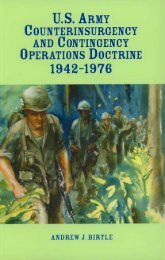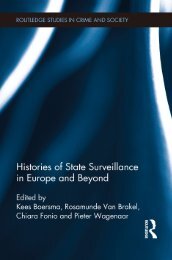C. Wiebes - Intelligence en de oorlog in Bosnië 1992-1995. De rol van de inlichtingen- en veiligheidsdiensten - Engels
C. Wiebes - Intelligence en de oorlog in Bosnië 1992-1995. De rol van de inlichtingen- en veiligheidsdiensten - Engels
C. Wiebes - Intelligence en de oorlog in Bosnië 1992-1995. De rol van de inlichtingen- en veiligheidsdiensten - Engels
- No tags were found...
Create successful ePaper yourself
Turn your PDF publications into a flip-book with our unique Google optimized e-Paper software.
194To date little is known about the <strong>rol</strong>e of Sig<strong>in</strong>t and the <strong>in</strong>terception of communications traffic dur<strong>in</strong>gthe war <strong>in</strong> the Balkans and <strong>in</strong> Bosnia <strong>in</strong> particular. This is chiefly because Sig<strong>in</strong>t is one of the mostsecret methods of gather<strong>in</strong>g <strong>in</strong>tellig<strong>en</strong>ce.To beg<strong>in</strong> with we need a good <strong>de</strong>f<strong>in</strong>ition of Sig<strong>in</strong>t. A US Mar<strong>in</strong>e Corps manual <strong>de</strong>scribes it as‘<strong>in</strong>tellig<strong>en</strong>ce ga<strong>in</strong>ed by exploit<strong>in</strong>g an adversary’s use of the electromagnetic spectrum with the aim ofga<strong>in</strong><strong>in</strong>g un<strong>de</strong>tected firsthand <strong>in</strong>tellig<strong>en</strong>ce on the adversary’s <strong>in</strong>t<strong>en</strong>tions, dispositions, capabilities, andlimitations’. 1030 Sig<strong>in</strong>t <strong>in</strong>volves the acquisition of <strong>in</strong>formation from electromagnetic transmissions (ofany type whatsoever) aim<strong>in</strong>g to <strong>in</strong>tercept electronic message and data traffic and is always conductedun<strong>de</strong>r the greatest secrecy by technical means. This is usually conducted from ground stations, specialships, aircraft or satellites. Sig<strong>in</strong>t consists of three separate, mutually <strong>in</strong>terconnected gather<strong>in</strong>gtechniques: Communications <strong>Intellig<strong>en</strong>ce</strong> (Com<strong>in</strong>t), Electronic <strong>Intellig<strong>en</strong>ce</strong> (El<strong>in</strong>t) and ForeignInstrum<strong>en</strong>tation Signals <strong>Intellig<strong>en</strong>ce</strong> (Fis<strong>in</strong>t). 1031Communications <strong>Intellig<strong>en</strong>ce</strong> (Com<strong>in</strong>t) conc<strong>en</strong>trates on <strong>in</strong>tercept<strong>in</strong>g and process<strong>in</strong>g domesticand foreign communications by means of voice and data traffic through telephone, radio, Morse, co<strong>de</strong>,fax, vi<strong>de</strong>o and telegraph l<strong>in</strong>ks, and by means of other electronic media. Com<strong>in</strong>t does not relate to the<strong>in</strong>terception of postal traffic or the monitor<strong>in</strong>g of foreign radio and TV broadcasts. 1032 A typical targetof Com<strong>in</strong>t dur<strong>in</strong>g the Cold War was formed by the rout<strong>in</strong>e activities of Soviet airfields <strong>in</strong> the GDR,Poland and elsewhere: the radio l<strong>in</strong>ks, the traffic betwe<strong>en</strong> the ground personnel and the cont<strong>rol</strong> towers,the conversations of the pilots and the weather reports for the pilots.Electronic <strong>Intellig<strong>en</strong>ce</strong> (El<strong>in</strong>t) conc<strong>en</strong>trates on all the other <strong>in</strong>formation and data traffictransmitted by domestic and foreign electronic equipm<strong>en</strong>t. The most common El<strong>in</strong>t targets aretransmissions by radar stations and navigation systems. By means of El<strong>in</strong>t these radars can be id<strong>en</strong>tifiedby function, type, range and capabilities and their location can be precisely <strong>de</strong>term<strong>in</strong>ed. This <strong>in</strong>tellig<strong>en</strong>ce1033is chiefly of importance to the Military <strong>Intellig<strong>en</strong>ce</strong> Services. Foreign Instrum<strong>en</strong>tation Signals<strong>Intellig<strong>en</strong>ce</strong> (Fis<strong>in</strong>t) <strong>in</strong>volves the gather<strong>in</strong>g and process<strong>in</strong>g of emissions related to the test<strong>in</strong>g of certa<strong>in</strong>aircraft, missiles and (un)manned space vehicles. Fis<strong>in</strong>t is also <strong>in</strong>volved <strong>in</strong> the <strong>in</strong>terception of electronictraffic transmitt<strong>in</strong>g vi<strong>de</strong>o images to ground stations, and of transmissions <strong>in</strong>t<strong>en</strong><strong>de</strong>d to test all sorts ofweapons systems. 1034Over the last t<strong>en</strong> years Sig<strong>in</strong>t has <strong>in</strong>creas<strong>in</strong>gly be<strong>en</strong> used to <strong>in</strong>tercept a new electroniccommunication medium: digital data traffic. Its ma<strong>in</strong> purpose is to transmit <strong>en</strong>ormous quantities ofdigital data betwe<strong>en</strong> computer systems and networks. One example is a special program for themonitor<strong>in</strong>g of electronic bank<strong>in</strong>g traffic. This program was used, for <strong>in</strong>stance, to closely monitorMilosevic’s cash flows abroad (especially to and from Cyprus). 1035 Dur<strong>in</strong>g the Balkan war too the<strong>in</strong>tellig<strong>en</strong>ce services <strong>de</strong>voted att<strong>en</strong>tion to Com<strong>in</strong>t, with particular att<strong>en</strong>tion giv<strong>en</strong> to the gather<strong>in</strong>g,<strong>in</strong>tercept<strong>in</strong>g and <strong>de</strong>cod<strong>in</strong>g of military and diplomatic messages. This traffic can be conducted over an‘op<strong>en</strong>’ l<strong>in</strong>e, but it may also be co<strong>de</strong>d or <strong>en</strong>crypted. In cryptography (the art of secret writ<strong>in</strong>g)<strong>in</strong>formation is converted <strong>in</strong> a way that third parties are not thought capable of <strong>de</strong>cipher<strong>in</strong>g.1030 US Mar<strong>in</strong>e Corps, Mar<strong>in</strong>e Corps Warfight<strong>in</strong>g Publication (MCWP), 2-15.2, Sig<strong>in</strong>t, June 1999, p. 1-1.1031 US House of Repres<strong>en</strong>tatives, Perman<strong>en</strong>t Select Committee on <strong>Intellig<strong>en</strong>ce</strong>, Annual Report by the Perman<strong>en</strong>t Select Committeeon <strong>Intellig<strong>en</strong>ce</strong>, 95th Congress, 2nd Session, 1978, p. 50.1032 US S<strong>en</strong>ate, Report No. 94-755, F<strong>in</strong>al Report of the Select Committee to Study Governm<strong>en</strong>tal Operations With Respect to <strong>Intellig<strong>en</strong>ce</strong>Activities, 94th Congress, 2nd Session, 1976, Book III, p. 737; US House of Repres<strong>en</strong>tatives, Perman<strong>en</strong>t Select Committeeon <strong>Intellig<strong>en</strong>ce</strong>, Report No. 95-1795, Annual Report by the Perman<strong>en</strong>t Select Committee on <strong>Intellig<strong>en</strong>ce</strong>, 1978, pp. 31, 58; <strong>De</strong>partm<strong>en</strong>tof <strong>De</strong>f<strong>en</strong>se Directive S-5100-20, The NSA and the C<strong>en</strong>tral Security Service, 23/12/71; David L. Christianson, ‘sig<strong>in</strong>t’, <strong>in</strong>: Hopple& Watson (eds.), The Military <strong>Intellig<strong>en</strong>ce</strong> Community, p. 41.1033 E.A.O. On<strong>de</strong>r<strong>de</strong>l<strong>in</strong>d<strong>en</strong>, ‘Verb<strong>in</strong>d<strong>in</strong>gs<strong>in</strong>licht<strong>in</strong>g<strong>en</strong>. Wat is dat eig<strong>en</strong>lijk?’ (Signals <strong>Intellig<strong>en</strong>ce</strong>. What is that actually?), <strong>in</strong>:Militaire Spectator, Vol. 170 (2001) 12, pp. 675-683.1034 Fis<strong>in</strong>t was earlier known as Telemetry <strong>Intellig<strong>en</strong>ce</strong>. David L. Christianson, ‘sig<strong>in</strong>t,’ <strong>in</strong>: Hopple & Watson (eds.), TheMilitary <strong>Intellig<strong>en</strong>ce</strong> Community, p. 40.1035 NAIC, Draft, Technical Requirem<strong>en</strong>ts Docum<strong>en</strong>t (TRD) for the SIGINT System Integration Contract, 24/07/00. See:http://www.pixs.wpafb.af.mil/pixslibr/DATAEX/sigsoo_drft1.doc.





